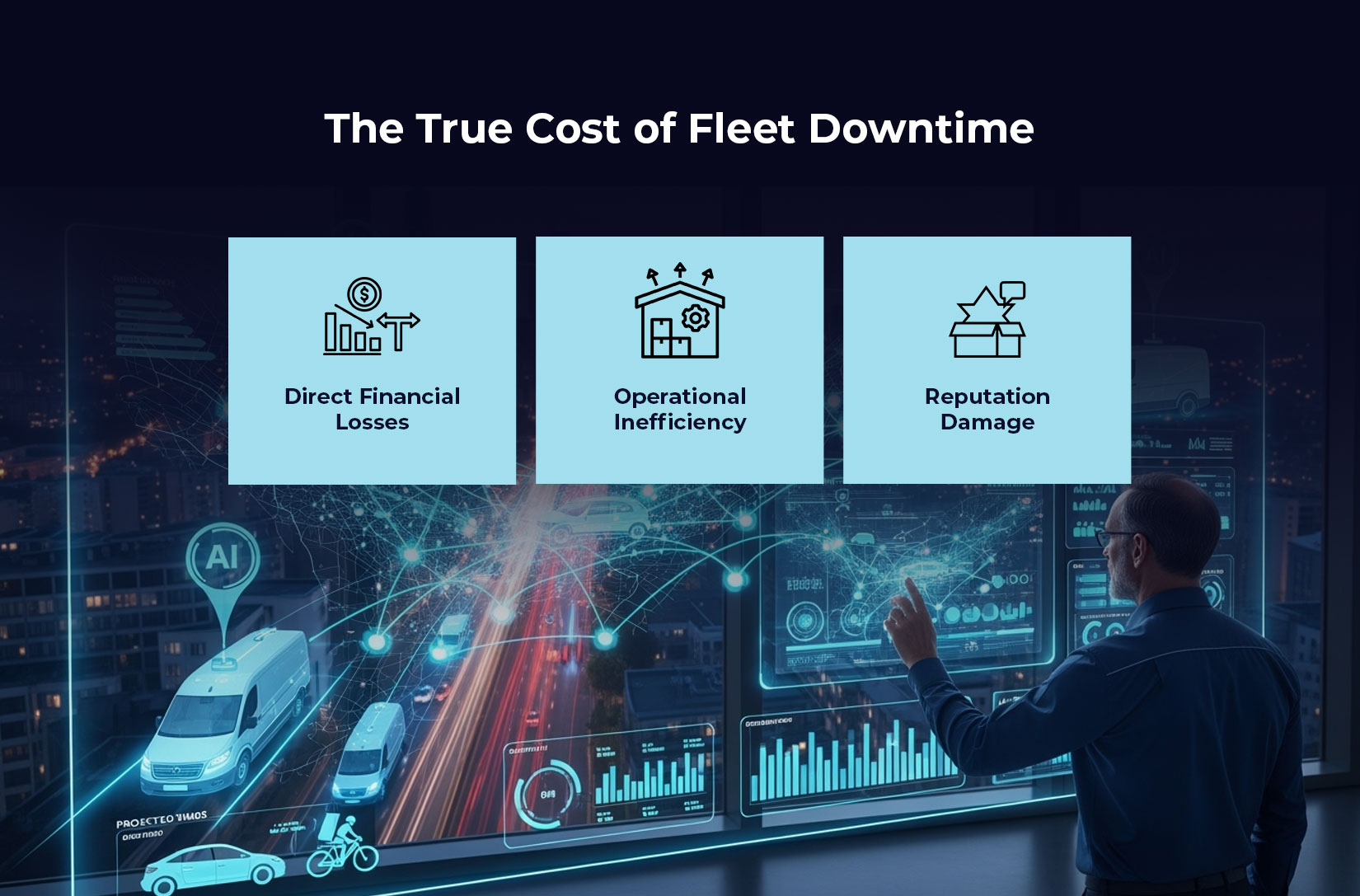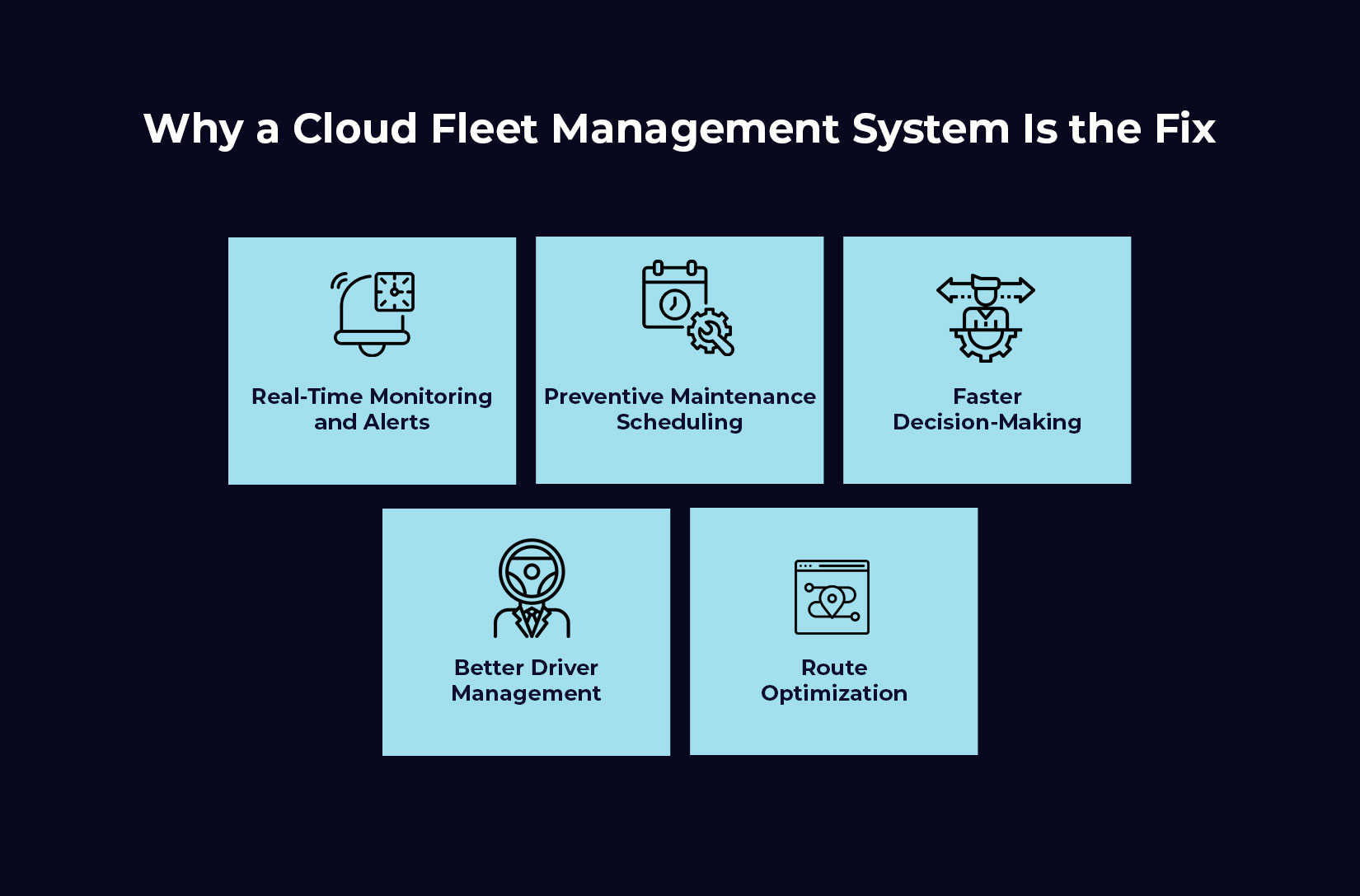
Fleet Downtime Costs Too Much – Here’s How Cloud Fleet Management Fixes It
In the field of logistics, time is money in literal sense. A single truck stuck in downtime, can cost around $448 to $760 a day to the company, as per the American Trucking Associations. This is just the cost of one truck, now multiply it by the whole fleet and the financial impact becomes huge. Downtime not only eats the profits but also damages the customer trust, disrupts delivery schedules and strains operations. This is where cloud fleet management system comes into the picture.
Traditional fleet management tools rely heavily on manual oversight or outdated on-premise software. However, cloud based solutions provide real-time visibility, predictive insights and scalable control. They not only track vehicles but also reduce downtime and costs.
In this blog we will explore how a cloud based fleet management system helps companies eliminate waste, minimize downtime. And also improve overall fleet efficiency.
The True Cost of Fleet Downtime

Before diving into solutions, it’s important to understand why downtime is so damaging:
1. Direct Financial Loses:
Every day a vehicle is idled translates into hundreds in lost revenue, labor and emergency repairs. When margins are so thin that one day of downtime eliminates profit earned from several successful trips, downtimes are one of the costliest operational risks.
2. Operational Inefficiency:
Downtime rarely affects only one vehicle. Inevitably others will be affected as the remaining trucks are forced to assume the burden. Thereby, leading to extended shifts, increased fuel usage, and delayed material movement inside warehouses. Which only magnifies further delays along the supply chain.
3. Reputation Damage:
Reliability is everything in logistics. Frequent downtime is synonymous with unreliability. Per PwC, 86% of buyers would pay more for reliable service, any downtime simply destroys trust and revenue.
Why a Cloud Fleet Management System Is the Fix

A Cloud Fleet Management System solves these issues by centralizing fleet data and making it accessible anytime, anywhere. It connects drivers, vehicles, managers, and even customers into one ecosystem. Here’s how it tackles downtime directly:
1. Real-Time Monitor and Alerts:
A cloud-based fleet management solution allows employees to monitor the health and performance of vehicles in real-time. Automatic alerts that indicate issues such as low tire pressure, engine codes, overdue service, etc., either notify the driver or fleet manager before a potential breakdown occurs. With predictive maintenance, the chances of an unexpected breakdown can be reduced by at least 25%.
2. Preventive Maintenance Scheduling:
A cloud fleet management software keeps track of the vehicle’s maintenance history and schedules servicing based on mileage, usage, or calendar time. Automatic reminders mean that no inspection or repair is overlooked. On average, fleets will see a 15–20% reduction in maintenance costs.
3. Faster Decision-Making:
The time it takes to approve repairs or replacements can be lengthy in a fleet. A cloud-based management system can provide users with access to data to agree on repairs and track progress instantly; location is not a barrier. Repairs and approvals will take less time to process.
4. Better Driver Management:
Driver behavior also plays an important role in preventing downtime. Cloud solutions record driver behavior around idling, hard breaking, speeding, etc. By addressing driver behavior concerning safety and efficiency, fleets can reduce wear and tear and improve the lifespan of vehicles. Fleets who monitor their drivers’ behavior report 20–30% fewer mechanical issues with their vehicles.
5. Route Optimization:
When one vehicle is down, others step up to fill in. Cloud fleet management software automatically adjusts routes to keep serious impacts to a minimum. Fleet operations can manage route plans and avoid delays in delivery time while working to reduce vehicle capacity.
Additional Benefits Beyond Downtime Reduction
Investing in a cloud-based fleet management system offers more than just a solution to downtime, it changes logistics operations in many ways:
1. Scalability:
Businesses can add and remove vehicles, users, and features without costly investments in infrastructure. Thereby, making cloud fleet management perfect for small scale and multinational organizations.
2. Data Security:
Cloud service providers give their customers enterprise-level encryption, automatic backups, and maintenance in accordance with regulations. Thus, meaning sensitive fleet and customer data is safer than ever.
3. Integration:
The cloud fleet management system integrates with the logistics apps companies are already using, telematics, ERP and even IoT devices. Thus creating a seamless experience from one workflow to the next.
4. Cost Savings:
Companies can consistently expect an average 12% reduction in operational costs, thereby enhancing performance on the bottom line, every year.
Case in Point: Real-World Impact
A mid-sized logistics company running a fleet of 500 trucks reported more than $2 million in losses in downtime every year. Trucks were constantly going down and breaking down on the road. Delays were uncertain due to lack of visibility and scheduling delays were commonplace. After implementing a cloud fleet management system:
– 22% reduction in breakdowns.
– 18% reduction in repair times.
– $1.2 million saved in one year.
The organization experienced real-time visibility, accelerated approvals for repairs, and predictive maintenance all by moving to the cloud. This organization also learned that they could greatly reduce delays or downtime, at relatively no cost when the cloud technology is properly applied.
Conclusion
Fleet downtime is one of the most expensive hidden costs in logistics. But it doesn’t have to be. A Cloud Fleet Management System equips businesses with the tools to predict, prevent, and resolve issues before they spiral into costly disruptions.
Whether you’re running 50 vehicles or 5,000, moving to a cloud-based fleet management system ensures your operations remain lean, reliable, and profitable. In a world where every minute matters, keeping your fleet on the road isn’t just an option, it’s survival. So click on the red button below and book a demo with LogiNext Solutions today.
40







@LogiNext